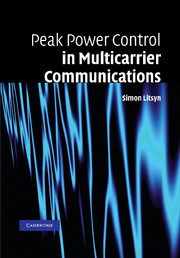Book contents
- Frontmatter
- Contents
- List of figures
- List of abbreviations
- List of notation
- 1 Introduction
- 2 Multicarrier signals
- 3 Basic tools and algorithms
- 4 Discrete and continuous maxima in MC signals
- 5 Statistical distribution of peak power in MC signals
- 6 Coded MC signals
- 7 MC signals with constant PMEPR
- 8 Methods to decrease peak power in MC systems
- Bibliography
- Index
1 - Introduction
Published online by Cambridge University Press: 03 December 2009
- Frontmatter
- Contents
- List of figures
- List of abbreviations
- List of notation
- 1 Introduction
- 2 Multicarrier signals
- 3 Basic tools and algorithms
- 4 Discrete and continuous maxima in MC signals
- 5 Statistical distribution of peak power in MC signals
- 6 Coded MC signals
- 7 MC signals with constant PMEPR
- 8 Methods to decrease peak power in MC systems
- Bibliography
- Index
Summary
In the mountains the shortest way is from peak to peak, but for that route thou must have long legs.
F. Nietzsche, Thus Spake ZarathustraMulticarrier (MC) modulations such as orthogonal frequency division multiplexing (OFDM) and discrete multitone (DMT) are efficient technologies for the implementation of wireless and wireline communication systems. Advantages of MC systems over single-carrier ones explain their broad acceptance for various telecommunication standards (e.g., ADSL, VDSL, DAB, DVB, WLAN, WMAN). Yet many more appearances are envisioned for MC technology in the standards to come. A relatively simple implementation is possible for MC systems. Low complexity is due to the use of fast discrete Fourier transform (DFT), avoiding complicated equalization algorithms. Efficient performance of MC modulation is especially vivid in channels with frequency selective fading and multipath. Nonetheless, still a major barrier for implementing MC schemes in low-cost applications is its nonconstant signal envelope, making the transmission sensitive to nonlinear devices in the communication path. Amplifiers and digital-to-analog converters distort the transmit signals leading to increased symbol error rates, spectral regrowth, and reduced power efficiency compared with single carrier systems. Naturally, the transmit signals should be restricted to those that do not cause the undesired distortions. Areasonable measure of the relevance of the signals is the ratio between the peak power values to their average power (PAPR). Thus the goal of peak power control is to diminish the influence of transmit signals with high PAPR on the performance of the transmission system. Alternatives are either the complete exclusion of such signals or an essential decrease in the probability of their appearance.
Information
- Type
- Chapter
- Information
- Publisher: Cambridge University PressPrint publication year: 2007
